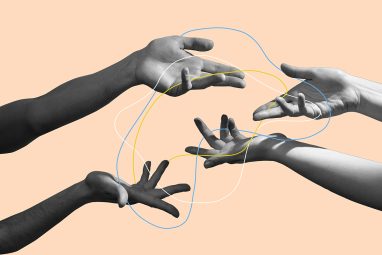A Radical Rethink of HR
Human resources needs to rethink its role as an agent of management and become a passionate advocate for employees and their interests.
News
- Identity-based Attacks Account for 60% of Leading Cyber Threats, Report Finds
- CERN and Pure Storage Partner to Power Data Innovation in High-Energy Physics
- CyberArk Launches New Machine Identity Security Platform to Protect Cloud Workloads
- Why Cloud Security Is Breaking — And How Leaders Can Fix It
- IBM z17 Mainframe to Power AI Adoption at Scale
- Global GenAI Spending to Hit $644 Billion by 2025, Gartner Projects

Carolyn Geason-Beissel/MIT SMR | Getty Images
For the human resources profession, this has been the best of times and the worst of times. Early in 2020, as the realities of the pandemic set in, all the big issues were HR issues and the function was challenged and valued as never before. Four years later, HR is asked to return to its traditional role of bridging between what business leaders insist on and what will keep the workforce at least partly happy. Some employees have been forced back to the office, against their wishes, and the only reason we’re no longer talking about quiet quitting is that we’re too busy grappling with the latest rounds of layoffs. So as we embark on the next era of work, the time is ripe for a rethink of HR.
To understand what the contours of a new concept might be, let’s tease apart the various interests at play inside a company. Imagine a Venn diagram consisting of two circles. The first circle represents the interests of a particular business. We’re quite familiar with the sorts of things it contains: Gain market share. Create better products. Invest in new opportunities. Drive efficiencies. Optimize the organization. The people-related things in this first circle include ensuring that the workforce has the right skills, or managing labor costs, or building a roster of strong leaders. These are all, obviously, necessary parts of running a business, especially one of any size, and they’re all perfectly good things. But they are not the only things, either.
So let’s consider the second circle. This circle represents not the interests of the business, as the first one does, but rather the interests of the people working there. It contains some things that are extrinsic — getting paid a fair wage, getting promoted — and many more things that are intrinsic — doing work that makes a difference, belonging to a supportive team, doing work that’s interesting and challenging at the same time, getting better at something, and so on. The second circle contains all the things that make a job worthwhile for the person doing it.
Now, the first important point to make is that our two circles do not perfectly line up with each other. There are things that are in the interests of the business that are very much not in the interests of employees (layoffs, restructurings, late-night emails, open-plan offices, long-haul travel in coach); and there is plenty of stuff that is in the interests of employees but not very much in the interests of the business (raises, vacations, sleep). In the olden days, the fact that the circles don’t exactly align was made up for by pay and benefits, the function of which was to compensate people for some stuff that wasn’t great (hence, in one sense, compensation). Again, a non-crazy proposition: Because we (the business) recognize that there’s some stuff that’s a little bit sucky for you (the employees), we should do something to make up for this and induce you to hang around, whether that something is money, or benefits, or wellness gurus, or foosball tables, or Instagrammable offices.
Even if that approach were ever really sufficient, it certainly isn’t now, as the widening gap between companies and their workers illustrates. The unwillingness of employees to mutely accept what their employers have to offer is a reflection of the importance of the second circle — employees’ interests — and a reflection as well of the perception that between them, business leaders and HR have inadequately addressed those concerns.
HR and the Second Circle
Right now, HR sees itself as the implementation arm of the people-related things in the first circle — and this certainly appears to be the role that most businesses want it to play. In many organizations today, HR functions either as an agent of management or as a slightly awkward mediator between employees and management, trying to explain what’s going on to employees while nudging management in a better direction.
But this brings us to the second important point, which is that notwithstanding the fact that these two circles are different, they do nevertheless overlap. There are things that are quite naturally in the interests of both the business and its employees. The business would like people who are at the top of their game, and people like to spend time doing what they do best. The business would like better products, and people like to improve things. The business would like strong relationships with its customers and partners, and people like to form strong relationships.
That’s why I maintain that HR’s fundamental accountability must be for all the things in the second circle. HR should become a full-throated advocate for employees and their interests. It should be an expert in understanding the employee experience on the front lines (not just as relayed via senior management) quantitatively and qualitatively, and it should be an expert in what humans need in order to do their best work and to make their fullest contribution. Given that the long-term interests of any organization and the long-term success of its people are one and the same, an enlightened leadership team will ask HR to play this role, and will empower it to do so.
One good way for HR to embrace this accountability would be to make the overlap between the circles as big as possible — to argue for all the things that serve everyone’s interests, and to identify more investments and programs and systems and other initiatives that lift all boats. Creating a methodology to support great teams is one example — great teams produce innovation and performance and all sorts of other, first-circle things; at the same time, a great team offers an essential human experience to all its members and so is also an instance of a second-circle thing. Introducing programs to help people use and share their strengths is another example — when people spend more time doing what they do best, the quality of their work increases (first circle), as do the intrinsic rewards of doing great work (second circle).
This is to argue that HR should return to its roots — concerning itself not just with the things that affect people (often negatively), but with the things that people need. In this sense of returning to fundamentals, HR should be radicalized. It’s time for all of us in the profession to take ourselves seriously as the people who best understand the essential conditions of human flourishing, and who are best positioned to advocate for those and thereby to unlock performance, innovation, and productivity.
Here’s what that looks like.
Time for HR to Refocus: Three Key Steps
The first step is to understand what life is actually like in the second circle. This means to create and share quantitative and qualitative measures of employee experience. But there’s a challenge here: If the chosen approach — the all-employee survey or feedback session or similar — is designed and explained as something to serve and inform management, then participation rates will be low, data will be poor quality, and it will only be possible to collect it once or twice a year, for fear of creating survey fatigue. The trick is to figure out how to create data that is massively useful for teams on the front lines, to figure out how to get it in their hands as quickly as possible, and only then to aggregate it up the organization to provide a broader measure.
At Cisco, we created a brief team-level engagement survey that team leaders could trigger themselves, without HR’s say-so. The results came back to them in a couple of days, because most people move a bit faster when the request for input comes from their immediate boss. The team could discuss the results together, and decide what changes they wanted to make in how they worked together. HR, meanwhile, could tally the scores across the organization and get a real-time and reliable pulse of the day-to-day experience of work.
The second step begins with the recognition that training of those team leaders is a non-optional investment in second-circle health. Our teams at work are the single biggest determinant of our experience at work, and team leaders have an outside influence on the experience of being on a particular team. Today, however, much leadership training is an afterthought. We promote people to leadership roles because they’ve excelled at non-leadership jobs and we offer them a couple of weeks of training at some point in their first year. The support we give them is mainly concerned with how to operate the performance management system or the compensation system — both artifacts of the first circle.
What would it look like if, instead, we trained team leaders as though theirs was the most important job in the company? For starters, we would surely begin their training before offering them the role, and consider their performance in training as part of their eligibility (and we would ask team leaders joining from other companies to meet the same standards).
We would start leaders out with small teams, and only consider them for more senior roles when they had demonstrated their people leadership acumen, not just their ability to deliver business results. And we would support leaders with ongoing refresher training, or special sessions dedicated to emerging topics of interest. In short, we would treat the development and support of team leaders as a system, worthy of sustained investment over many years, rather than as a one-time morale-boosting event when budget allows.
The third and last step, meanwhile, would rethink how HR itself is structured. At the moment, in most large organizations HR maps its resources to the leadership structure of the business — so when a function attains a certain size, it is assigned an HR generalist to sit at the leadership table and advise the senior team. The structure of HR, in other words, is a first-circle structure. And this, in turn, shapes HR’s cognitive model of itself — if you ask HR professionals what the role of HR is, they will tell you in some form or another that it exists to serve the interests of the business, because these are the interests that they are most frequently exposed to.
A second-circle HR organization would instead map itself to the teams, and their team leaders, and their interests. Every HR professional would have a portfolio of teams assigned to them, and would be asked to check in with each of these teams and their leaders every couple of weeks. For some, supporting a portfolio of teams like this would be a full-time job; for others, it would be something to do in addition to other responsibilities. But for everyone in HR, it would be a chance to engage directly with the needs of the people on the front lines, and to help meet those needs.





